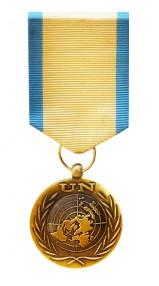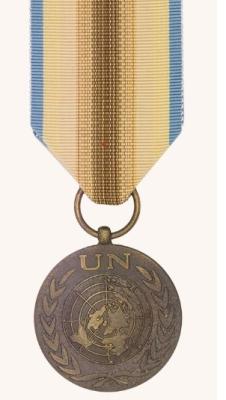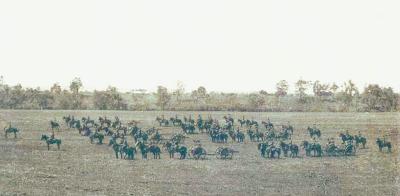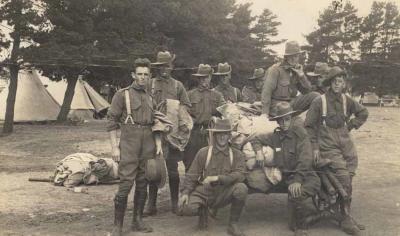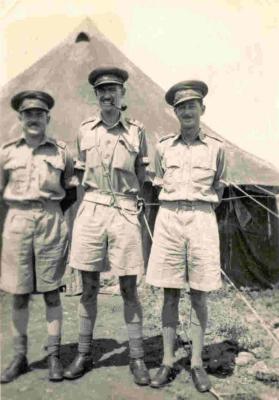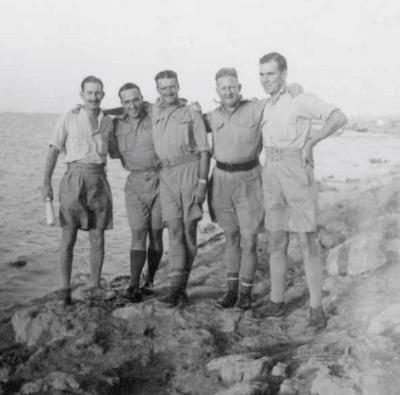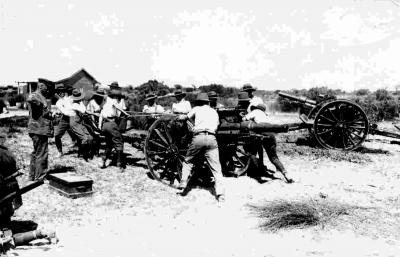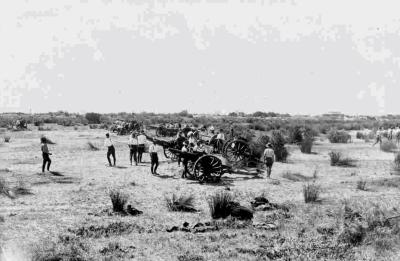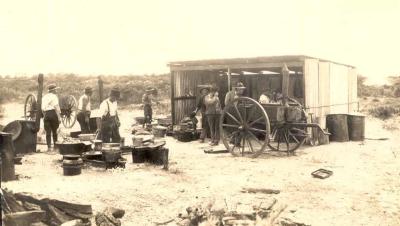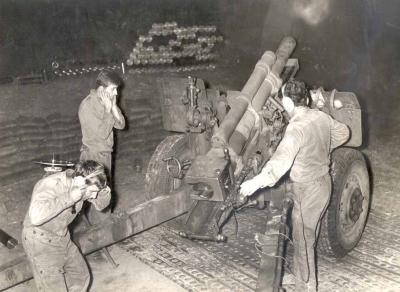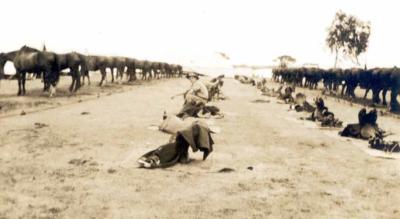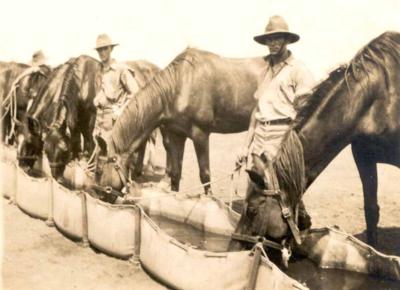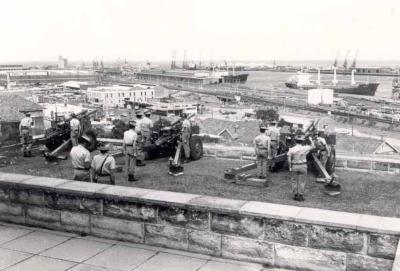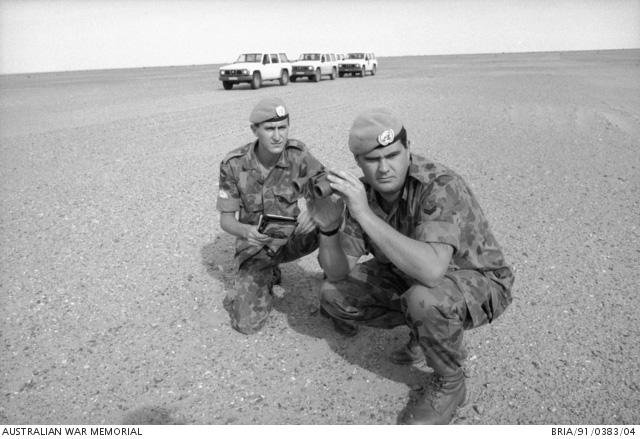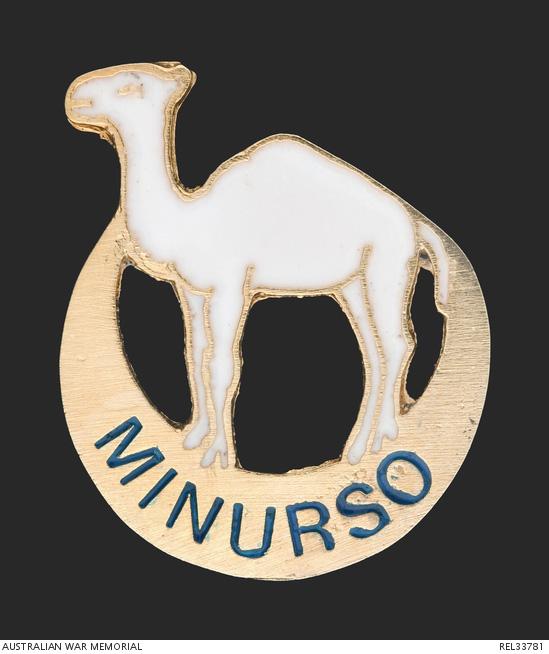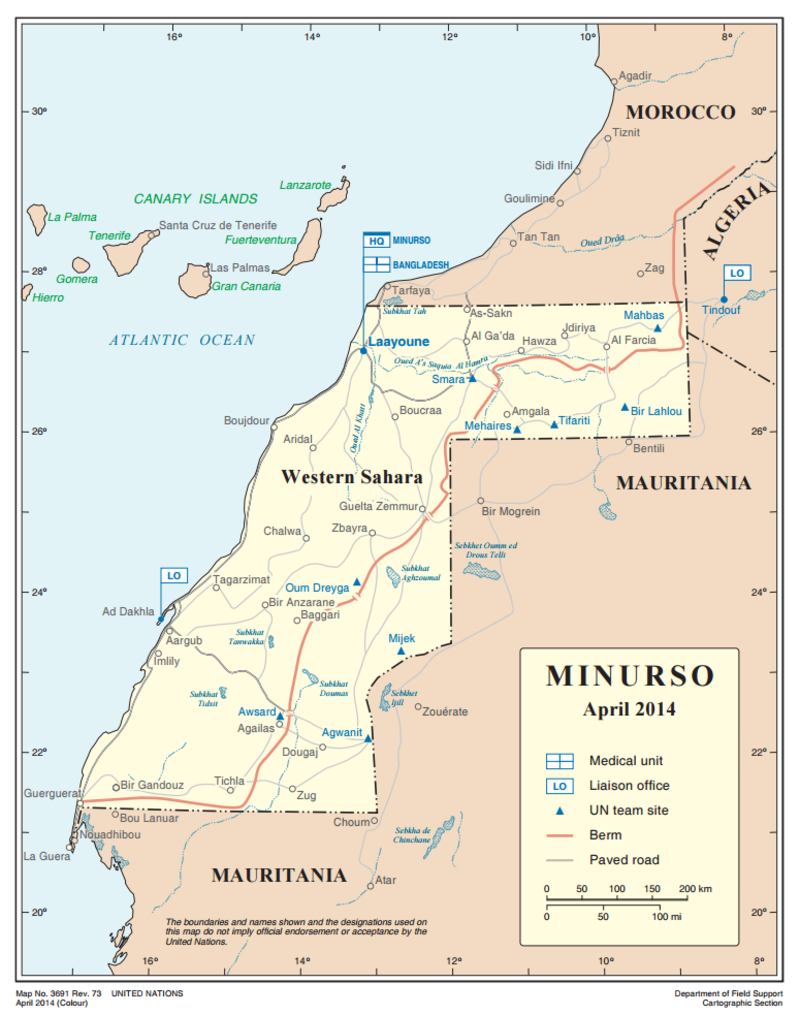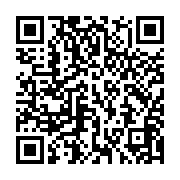Post 1945, Peacekeeping, United Nations Mission for the Referendum in Western Sahara (MINURSO), 1991 to 1994
Photograph of Corporals Colin Gamble and Greg Scanlon in the desert of Western Sahara. They were members of an Australian Army contingent (mostly from the 1st Signals Regiment) with MINURSO. Photo taken December 1991 by T.R. Dex. AWM BRIA/91/0383/04
The implementation of the truce in the former Spainish Sahara was to be overseen by a multinational peacekeeping force known as the United Nations Mission for the Referendum in Western Sahara (MINURSO, from the Spanish Misión de las Naciones Unidas para la Organización de un Referéndum en el Sáhara Occidental).
Under Operation Cedilla, Australia provided 5 contingents to MINURSO, each with up to 45 signals personnel, between September 1991 and May 1994.
Disagreements between Morocco and the Polisario Front mean that the terms of the truce are still being negotiated today.
Western Sahara is an arid desert territory on the north-west coast of Africa that shares borders with Morocco, Mauritania and Algeria. Until 1975, Western Sahara, known then as Spanish Sahara, was colonised and governed by Spain as part of the Spanish Empire. In November 1975, Morocco sent around 350,000 unarmed Moroccans accompanied by the heavily armed Moroccan Army into Western Sahara. Feeling pressured, Spain reached an agreement with Morocco and Mauritania, known as the Madrid Accords.
Under the agreement, Spain would withdraw and hand governing control of the territory to both neighbouring countries.
Already discontented with Spanish occupation, the Polisario Front, led by indigenous Sahrawi people, launched a guerrilla campaign against invading forces from Morocco and Mauritania. The territorial dispute led to a 16-year insurgency. It lasted until the United Nations (UN) organised a truce in 1991.
The terms of the truce included a supervised ceasefire and a referendum to decide on Western Sahara's independence.
The implementation of the truce in the former Spainish Sahara was to be overseen by a multinational peacekeeping force known as the United Nations Mission for the Referendum in Western Sahara (MINURSO, from the Spanish Misión de las Naciones Unidas para la Organización de un Referéndum en el Sáhara Occidental).
After 2 years of deployment in Western Sahara, it became clear that the planned referendum would not happen soon. Ongoing disagreements about key elements of the settlement plan continued, particularly around the terms of the election. In May 1994, the Australian Government withdrew its deployed forces from Western Sahara.
Details
Details
Under Operation Cedilla, 1991 to 1994 Australia provided 5 contingents of up to 45 people each. They served as signals staff to MINURSO between September 1991 and May 1994. In total Operation Cedilla, included around 220 Australians from the Australian Defence Force.The signals staff primarily provided combat radio and communications between force headquarters in Laâyoune to sector headquarters and team sites as required.
The contingent also delivered tanker and flat-bed truck fuel in 44-gallon drums and propane canisters to resupply team sites located on both sides of a 2,700 km-long defensive wall. The wall, known as the Berm, stretches the entire length of the disputed territory through Western Sahara and south-eastern Morocco. The western side is administered by Morocco, while the east is controlled by the Polisario Front.
On 21 June 1993, 32-year-old Major Susan Felsche was killed when her plane crashed as it took off from a remote base at Awsard. She was a medical officer serving in the fourth Australian contingent, which had arrived on 18 May 1993. Felsche was the first Australian woman to die in an overseas operation since World War 2.
National Peacekeepers' Day: On 14 September each year, Australia observes National Peacekeeper’s Day, the anniversary of Australia becaming the world's first peacekeepers to deploy into the field, in the Netherlands East Indies in 1947.
International Day of UN Peacekeepers: 29 May is a day of commemoration and acknowledgement of all military, police and civilian personnel who have served as peacekeepers with the UN. Since UN peacekeeping began, more than 4,000 peacekeepers from many countries have lost their lives while performing their duties under the UN flag.
Open in Google Maps
Nearest geotagged records: View all geotagged records »
Australian Army Museum of Western Australia
Australian Army Museum of Western Australia
More items like this
Other items from Australian Army Museum of Western Australia
- Medal, Post 1945, United Nations Yemen Observer Mission (UNYOM) 1963 - 1964
- World War 1, Western Australia, Upper Swan, Belhuis, 8 Battery AIF, 1914
- Inter War, Western Australia, Northam, 3 Field Artillery Brigade, 1924
- World War 2,Eastern Mediterranean, HUGGETT, FITZHARDINGE, MITCHELL, 2/7 Field Regiment
- World War 2, Eastern Mediterranean, 2/7 Field Regiment
- Inter War, Western Australia, 3 Field Artillery Brigade, 1924
- Inter War, Western Australia, 3 Field Artillery Brigade, 1924
- Inter War, Western Australia, 3 Field Artillery Brigade, 1924
- Post 1945, South Vietnam, Nui Dat
- Inter War, Western Australia, York, 3 Field Artillery Brigade, York, 1936
- Inter War, Western Australia, Northam, 3 Field Artillery Brigade, 1936
- Post 1945, Western Australia, Fremantle, Cantonment Hill, 7 Field Battery, Salute
